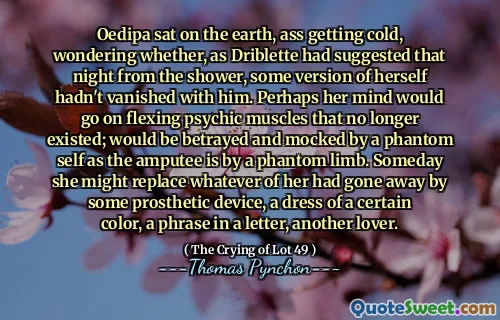Oedipa, perverse, had stood in front of the painting and cried. No one had noticed; she wore dark green bubble shades. For a moment she'd wondered if the seal around her sockets were tight enough to allow the tears simply to go on and fill up the entire lens space and never dry. She could carry the sadness of the moment with her that way forever, see the world refracted through those tears, those specific tears, as if indices as yet unfound varied in important ways from cry to cry.
In "The Crying of Lot 49" by Thomas Pynchon, the character Oedipa experiences deep emotional turmoil while observing a painting. She stands there, undetected by those around her, hidden behind dark green bubble shades. This moment of sorrow moves her to tears, provoking a contemplation about the possibility of carrying those tears within her for eternity. The lens of her sunglasses serves as a metaphor for her emotional state, allowing her to see the world through a unique and distorted perspective.
Oedipa's reflection on her tears suggests that each emotional experience can produce a different and significant impact, emphasizing the individuality of human emotions. The idea that these tears could continue to exist and affect her perception of reality highlights the complexities of grief and sadness. Pynchon expertly uses this moment to illustrate the interplay between perception, emotion, and the ways we process our experiences in relation to the world around us.






